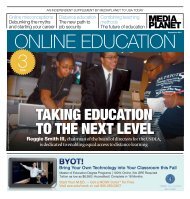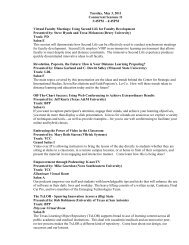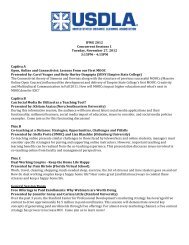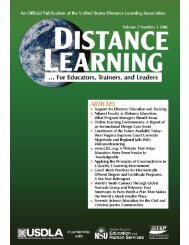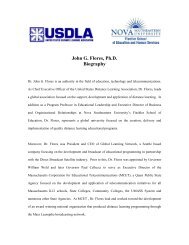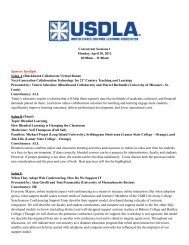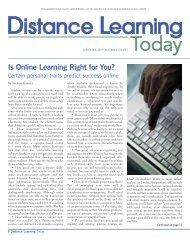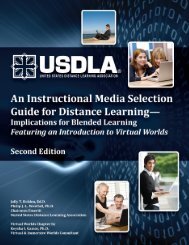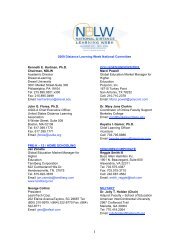United States Distance Learning Association
United States Distance Learning Association
United States Distance Learning Association
- No tags were found...
You also want an ePaper? Increase the reach of your titles
YUMPU automatically turns print PDFs into web optimized ePapers that Google loves.
FLEXIBILITY AND TIMEFRAMES OF<br />
DISTANCE EDUCATION<br />
<strong>Distance</strong> education brings with it the element<br />
of flexibility and the ability of high<br />
school students to be involved in many different<br />
areas of their own education while<br />
utilizing the financial benefits of online<br />
education at a distance. <strong>Distance</strong> education<br />
frees many students of the burden of overloaded<br />
schedules crammed into a few<br />
hours each day and has the added benefit<br />
of being accessible when the student is<br />
ready to learn.<br />
QUALITY OF EDUCATION IN<br />
DISTANCE EDUCATION<br />
Quality of education is more than taking<br />
many classes, it is the ability of the student<br />
to retain and learn the concepts being<br />
offered in the classes that will give them an<br />
edge when they enter college or the job<br />
force. The regular high school can no<br />
longer meet the demands for higher and<br />
higher level classes while combating the<br />
need to remediate the lower level achievers.<br />
As classes are slowed down to accommodate<br />
the lower-achieving student, more<br />
higher-achieving students are permitted to<br />
sit uninspired and unchallenged. <strong>Distance</strong><br />
education puts quality and value back into<br />
education as it offers upper level students<br />
the opportunity to learn in a challenging<br />
self-paced format.<br />
FACING THE CHALLENGES OF<br />
DISTANCE EDUCATION<br />
High school is a challenging endeavor for<br />
most students and compounding the challenges<br />
are the lack of interesting and<br />
diverse classes. With distance education<br />
offered at the local high school many students<br />
are able to take advantage of the<br />
high quality classes offered at a distance.<br />
Students are no longer limited to a single<br />
language class, but have the opportunity<br />
to take any one of a number of languages<br />
offered through the varying venues of distance<br />
education. Upper-level AP and honors<br />
classes are no longer being “squished”<br />
into the best time frame for the institution,<br />
but rather are being taken by students with<br />
the drive to succeed and the opportunity<br />
to take the class when it is best for the<br />
learner.<br />
INDEPENDENT LEARNING IN<br />
DISTANCE EDUCATION<br />
There are challenges directly associated<br />
with distance learning and, for some, the<br />
challenges make distance education all but<br />
impossible. <strong>Distance</strong> education is typically<br />
a form of education in which the learner is<br />
isolated from other learners. This does not<br />
mean that other students are not present<br />
while the student is engaged in the course;<br />
the contrary is true. In a typical classroom<br />
developed and maintained for the distance<br />
education student, there are many students<br />
present; however, few are engaged<br />
in the same class at the same time and<br />
rarely if ever are two or more students at<br />
the same place in the course. The distance<br />
learner must be a motivated and self-regulated<br />
learner. The isolation of distance<br />
learning can mean that a good student will<br />
not always find success, and a student who<br />
found the distractions of the classroom created<br />
an environment in which it was<br />
impossible to learn will be able to achieve<br />
at a higher level.<br />
INDIRECT COMMUNICATION IN<br />
DISTANCE EDUCATION<br />
Another challenge of distance learning is<br />
the inability to immediately confer with<br />
the teacher. Although many classes taken<br />
at a distance provide communication links<br />
through telephone or instant messaging,<br />
there is not the ability to walk up and show<br />
a teacher what one is experiencing problems<br />
with. As Arsham (2002) noted, “Some<br />
students may struggle with independent<br />
learning and feel insecure with an amorphous<br />
teacher” (para. 6). There is also the<br />
32 <strong>Distance</strong> <strong>Learning</strong> Volume 4, Issue 4



